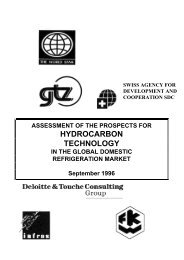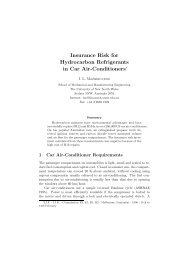HyChill Information Manual - HyChill Refrigerants
HyChill Information Manual - HyChill Refrigerants
HyChill Information Manual - HyChill Refrigerants
Create successful ePaper yourself
Turn your PDF publications into a flip-book with our unique Google optimized e-Paper software.
HR12 TECHNICAL INFORMATION<br />
MDS No: 1012 Page 1 of 2<br />
HYCHILL AUSTRALIA PTY LTD<br />
85A Canterbury Road Kilsyth VIC 3137 Phone: +61 3 9728 5055 Fax: +61 3 9761 8799<br />
Emergency Phone Number: +61 3 9728 5055<br />
MATERIAL SAFETY DATA SHEET<br />
Date Issued: 24 October 2001<br />
IDENTIFICATION<br />
PRODUCT NAME: HR12 Refrigerant Gas UN Number: 1965<br />
Other Names: Hydrocarbon Blend Hazchem Code: 2WE<br />
Dangerous Goods Class: 2.1 Subsidiary Risk: None<br />
Emergency Procedures Guide: 2A2 Manufacturers Code: HR12<br />
Poisons Schedule: None Allocated<br />
USE: A flammable gas used as refrigerant, normally stored under pressure in liquid form.<br />
PHYSICAL DESCRIPTION/PROPERTIES:<br />
Appearance: Rapidly evaporating liquid or gas with rotten cabbage - like odour<br />
Initial boiling point: -30°C to 0°C Vapour Pressure at 20°C: 490kPag<br />
Melting Point: Not Applicable Flash Point: -104 to 60°C<br />
Density @ 15°C: Approximately equal to 0.57 Solubility in Water: Very slight<br />
Lower Flammability Limit: 1.9% in air Upper Flammability Limit: 9.5% in air<br />
OTHER PROPERTIES:<br />
Evaporation Rate: Rapid Vapour Density: 1.5 to 2.0 air = 1<br />
Auto Ignition Point: ~460°C - ~470°C % Volatilise: 100%<br />
INGREDIENTS:<br />
Chemical Entity CAS Number Proportion<br />
C3 H8 74-98-6 0 to 50%<br />
CH(CH3)3 75-28-5 0 to 50%<br />
HR12 contains odourant ethyl mercaptan unless otherwise authorised. (recommended 25 mg/kg). This is detectable to 20% of its lower flammability limit.<br />
HEALTH HAZARD INFORMATION<br />
HEALTH HAZARDS<br />
Inhaled: May cause irritation of the respiratory tract. May also cause headaches or dizziness at moderate exposures.<br />
Asphyxiant: Causes unconsciousness and respiratory arrest at elevated exposures.<br />
Eye: Irritating if the liquid gets into the eyes, with a possible hazard from freezing due to rapid evaporation. Vapours in high<br />
concentration may also be irritating.<br />
Skin: Excessive prolonged contact to the liquid can cause skin irritation and frostbite due to rapid evaporation.<br />
Swallowed: Unlikely to be a problem, owing to high evaporation rate.<br />
Chronic: No effects reported from long term industrial exposure to this product.<br />
FIRST AID<br />
Inhaled: Avoid breathing vapours and fumes as much as possible. If someone is overcome by fumes, remove them to fresh air<br />
immediately. Rescuers should avoid becoming a casualty by wearing suitable respiratory protection. If the affected individual is not<br />
breathing, administer artificial respiration. Seek medical advice promptly in serious cases of over exposure.<br />
Eye: Avoid contact with the product. Remove any contact lenses carefully. Hold eyelids open and flush eyes with tepid water for 15<br />
minutes. Seek medical advice immediately for all eye contact.<br />
Where significant splashing of HR12 liquid may occur, eyewash facilities stations should be installed.<br />
Skin: Avoid skin contact with the liquid. Remove contaminated clothing and wash the exposed areas with plenty of soap and water.<br />
Seek medical advice if irritation or frostbite (see below) occurs.<br />
Swallowed: Unlikely to be a problem, owing to high evaporation rate.<br />
Frostbite: Obtain medical assistance. If medical advice is not available immediately, place casualty in a warm area as soon as possible<br />
and allow the injured area to warm gradually (further damage may occur if the area of injury warms too rapidly). DO NOT EXPOSE<br />
THE INJURED AREA TO EXCESS HEAT OR COLD (such as heat lamps, hot water, snow or ice). Gently cover or drape the injured<br />
area with clean material, such as dressing or sheet. To relieve pain, immerse the injured area in water which is near or at body<br />
temperature (35-40°C). If possible, get the casualty to exercise the injured area gradually. Give them something warm to drink, BUT<br />
NO ALCOHOL. Seek medical advice as soon as possible.<br />
ADVICE TO DOCTOR<br />
No specific treatment recommended. Treat symptomatically. Show a copy of this material safety data sheet to medical personnel<br />
dealing with cases of over exposure<br />
28




